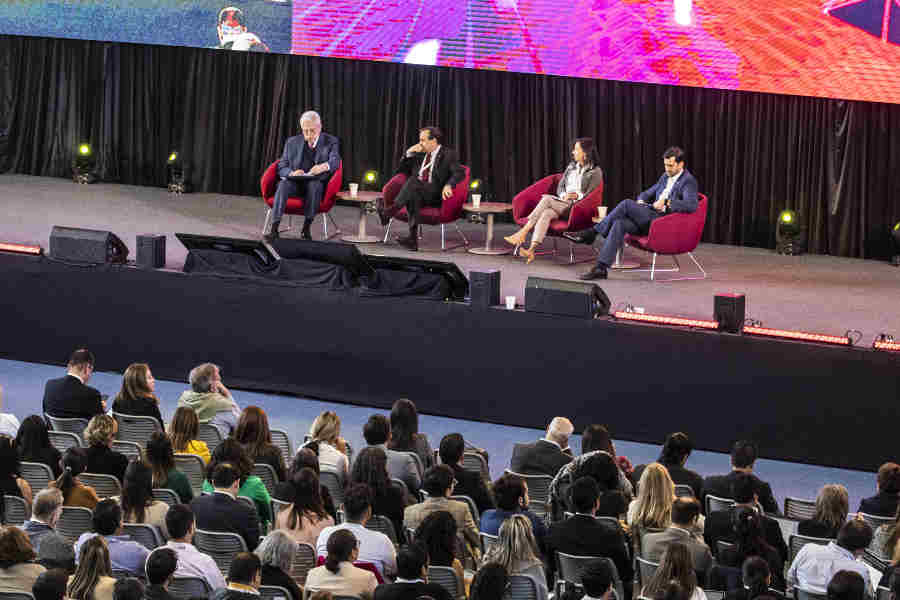Where is the education of the future headed? How should universities adapt to the challenges of post-pandemic education?
World experts from educational institutions and organizations gathered at Tec de Monterrey’s 9th International Conference on Educational Innovation, where they focused on discussing the priorities for the education of future generations.
Some of the key elements that specialists shared on education were issues such as adapting to the changes caused by the pandemic, updating programs according to the needs of the world, and being more flexible when offering programs and training.

Five key elements for the education of the future
“There are areas of opportunity that depend on adaptability, so they can be relevant to the demands of the future,” said Vincent Del Casino, Provost and Senior Vice President of Academic Affairs at San José State University.
That is why experts consider it essential to make adjustments to how people teach.
“In the 47 years that I have been in academia, I have never seen a time of so much change. The institutions that manage to adapt will survive and the rest will be obsolete,” said Rafael L. Bras from the Georgia Institute of Technology.
These are five issues that the experts suggest taking into consideration to shape the education of the future:
1. New curriculums adapted to the needs of the world
The experts identified areas of opportunity to update the skills and abilities of their students and graduates as part of the changes brought about by the-pandemic that affect our current social and economic reality.
“We should look for ways to mix the curriculum with the needs of the industry. We can offer educational opportunities to other types of people; we just have to be flexible,” explained Cheryl Regehr, Vice-President for the University of Toronto.
Leaders such as Regehr highlight the need to incorporate and emphasize meta-skills, those social skills that complement the technical side, as part of the university curriculum.
“We’ve realized that in our institution the skills model was not reflecting the potential of the students, so we worked to implement a language system capable of reflecting meta-skills,” she explained.
“Learning happens everywhere within a university, not just within the classroom. Nowadays, students seek to be trained in a holistic way,” Del Casino said on the value of soft skills.
Raúl Rodríguez, Associate Vice President of Internationalization at the Tec, talked to the panelists about the global concern that exists regarding a visible fragility in the mental health of students.
“There’s a new generation of young people who are showing alarming levels of hopelessness, loneliness, pessimism, anxiety, and even depression, which raises the question of what universities can do to tackle this challenge,” he said.
“Both students and teachers have shown a decline in their mental health, presenting issues such as insomnia, anxiety, and other complexities that affect their well-being and learning,” said Ignacio Sánchez from the Pontifical Catholic University of Chile.
On this subject, the rectors from La Tríada also highlighted the need to have institutional structures focused on prevention and support and provide safe spaces so that young people can learn by trial and error.
3. Technology as a support not a substitute for innovation
The education specialists agreed that although COVID allowed a move towards digital education, this experience taught universities that although it was possible, it still needed improving.
“We’ve seen incredible developments in educational technology such as global classrooms but it’s important to balance all this with the meta-skills,” said Regehr.
“Regarding the introduction of technology into an educational setting, I believe that it’s better to have less technology but be using it well,” said Del Casino.
“Universities invest a lot in technology, but there’s a lack of investment in teachers, in managing the technology they have, and in the support that is accessible to faculty and staff,” he added.
On the other hand, Raquel Bernal, Rector of the University of Los Andes, highlighted how the current understanding of educational innovation is strongly linked to the use of technology and technological trends.

“We must address the concept of educational innovation from its pedagogical origin, with an emphasis on where it comes from and how it’s used in the classroom,” Bernal said.
“Neuroscience has taught us a lot about how human beings learn and how this learning process changes throughout life, not only about learning continuously but doing it in a different way,” she explained.
Due to this apparently intrinsic behavior, leaders such as Sánchez insist that educational innovation can come from different points such as institutional processes, updating the curriculum, and the community itself.
“Technology is a very important element in educational innovation, but it shouldn’t be the only one,” he added.
3. Priority: forging responsible citizens
In the face of a panorama of growing competitiveness and a focus on training efficient graduates in their respective professions, the experts raised the need to reassess the presence of the human angle in this type of training.
“Due to the great challenges that have arisen, it’s vital to have holistic and interdisciplinary training, so we must set ourselves the task of creating integrated citizens who are capable of contributing to and transforming society,” said Bernal.
What’s more, the experts stressed how training graduates with technical skills along with well-founded social values is part of the responsibility of educational institutions to their communities.
“The biggest challenge of this disruption in educational innovation, is precisely that we must not focus solely on professionalization but remember that one of our main tasks as a university is to train citizens,” she added.
“We’ve managed to create a culture of educational innovation in which the community sees an opportunity along with a responsibility and an obligation to continue surpassing what has been achieved in the past,” said Juan Pablo Murra, Rector for Higher Education at Tec de Monterrey.
4. Lifelong learning that is accessible
According to Blas, one of the characteristics identified in the new generations of the 21st century is the need and desire for continuous learning.
“The nature of today’s job industry entails the need to be constantly changing and innovating, forcing us to prepare students for this competitive environment,” he explained.
This expert also highlighted how the cost of learning has created a problem linked to the accessibility of studies, particularly with regard to the university experience.
The situation has culminated in the emergence and support of programs that allow access to learning under a structure of greater flexibility in terms of cost and duration, even including the option of different formats.
“This type of education allows individuals who are working and want to improve themselves to do so, and also to be supported by their employer a lot of the time,” shared Rafael.
On the other hand, Blas shares the benefits of creating a technological infrastructure that is open to the public with the aim of encouraging the community to become part of a culture of innovation and shared learning.
“This culture of innovation cannot be created by accident. Institutions must undertake the task of creating spaces in which the public can access an ecosystem like this one,” he explained.
5. Promoting STEM education
Currently, 20 percent of jobs are based in the areas of Science, Technology, Engineering, and Mathematics (STEM).
“The STEM model helps foster critical thinking, boost problem-solving skills, build a sense of curiosity, and build resilience to meet the challenges of our times,” emphasized Nina Smidt, CEO and Spokesperson for the Board of Siemens Stiftung.
Kristina Reiss, an emeritus professor from the Technical University of Munich, pointed out that introducing boys and girls to STEM education “prepares them to develop ideas and solve problems in life.”
About the International Conference on Educational Innovation
The 9th International Conference on Educational Innovation (CIIE), organized by Tec de Monterrey’s Institute for the Future of Education (IFE), is a space for sharing trends and practices that are revolutionizing the world of education.
Since 2006, it has helped innovative people to improve education, making an impact on about 2 million people in 40 countries.
From January 16 to 18, CIIE 2023 is offering keynote speeches and panels, special events, exhibitions, networking sessions, sponsored events, and other events that are aimed at teachers, academics, graduates, and the general public.
During the inauguration of CIIE 2023, it was announced that its name will change next year to: IFE Conference 2024.
ALSO READ:








